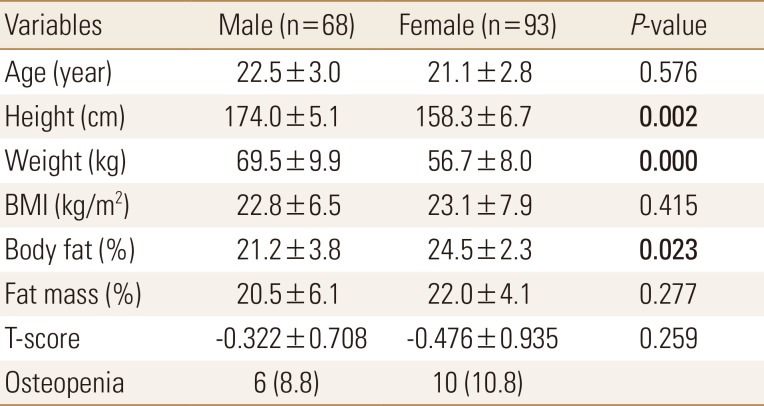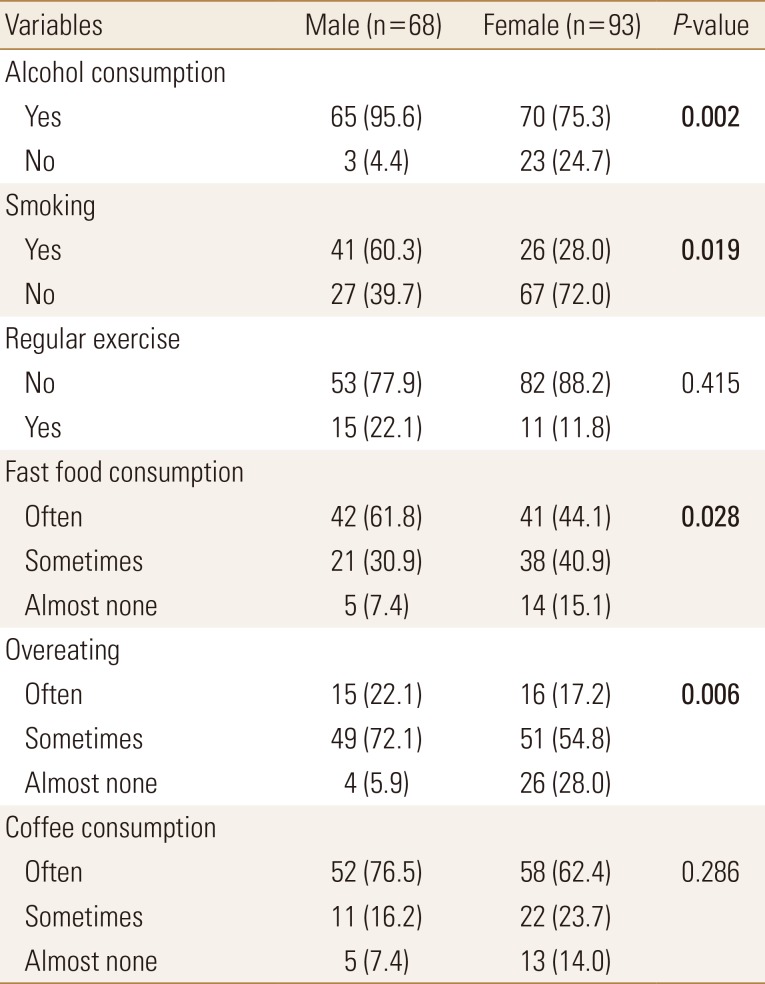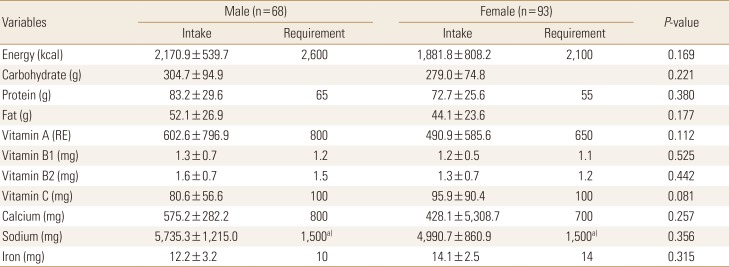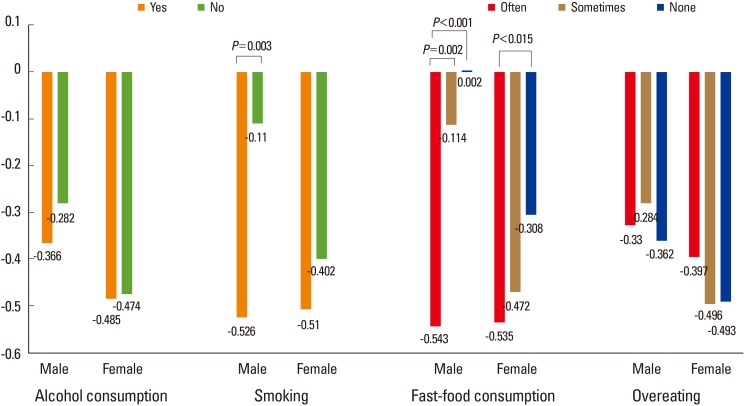Abstract
Background
The importance of bone health is emphasized throughout the life cycle. Young adults have problems with bone health due to irregular lifestyle and unbalanced diet, but studies related to them are insufficient. The purpose of this study was to measure the bone mineral density (BMD) of college students and to analyze the differences in BMD according to lifestyle.
Methods
BMD was measured by bone ultrasound in 161 male and female college students. The questionnaire was surveyed about lifestyle, eating habits, and nutrient intake status.
Results
Osteopenia was 8.8% in male and 10.8% in female. The body fat percentage of female was significantly higher than male. Male college students, smoking, fast food consumption, and overeating rate were significantly higher than female. Nutrient intake was not significantly different between male and female students. But energy and vitamin A and C levels were inadequate, and protein and sodium intake was excessive compared with the recommended nutrient intake for Koreans. BMD was significantly lowest in male who often intake fast food than male who did not intake at all or intake sometimes. Female who often intake fast food had significantly lower BMD than female who did not eat at all.
Go to : 
Interest in health is increasing with increasing life expectancy, emphasizing the importance of life cycle health care, not only for the elderly, but also for young adults and adolescents. Fracture and osteoporosis are common diseases, and their prevalence is increasing steadily.[1] An effective way of preventing adult osteoporosis is to maximize bone mass during adolescence. Maximum bone mass is reached around 30 years, and it is affected by genetic and environmental factors.[2] The National Institutes of Health (NIH) reported that failure to reach adequate bone mass in children and adolescents, including those in their 20s, could lead to osteoporosis without accelerating bone loss.[3] The main environmental factors affecting bone mineral density (BMD) are physical activity, lifestyle, and nutrient intake.[45] In particular, bone mass decreases more rapidly during pregnancy, delivery, and menopause in female.[6]
College students are at an age transitioning to adulthood, physically and socially. Being away from parental control of food intake, students become responsible for their diet, which should be sustained with adequate nutrition. However, many studies pointed out problems in college students' dietary habits such as irregular and skipping meals, inappropriate snacks, increased frequency of eating out, low nutrient density, and fast food intake.[78] Recently, to obtain an ideal body shape, certain nutrients have been intensively consumed, and the intake of carbohydrate-based meals such as Cupbap and Mini-kimbap has also increased.[910] Healthy lifestyle and dietary habits should be established in young adults to maintain maximum bone mass, but research on this subject is insufficient.
The purpose of this study was to investigate the dietary habits, nutrient intake, and BMD of college students and to identify the differences in bone density according to gender and lifestyle.
Go to : 
The subjects of the study were 168 college students. The purpose and method of the study were explained to them, and those who agreed answered a questionnaire and were evaluated in terms of anthropometry, BMD, and nutrient intake status. Seven participants were excluded because of incomplete data; finally, 161 students were included in the study (68 male and 93 female). We obtained Institutional Review Board (IRB) approval (IRB No. 1040875-201411-SB-028) from Soonchunhyang University on the design and progress of the overall research.
The body mass index, body fat percentage, and body fat mass were measured by using a bio-electrical impedance fatness analyzer (InBody 720; Biospace Co., Seoul, Korea). The BMD of the subjects was measured using quantitative ultrasonography QUS-2 (Metra Biosystems Inc., Mountain View, CA, USA) and calculated by broadband ultrasound attenuation. The BMD value was calculated by T-score, according to World Health Organization conversion standard (normal, −1.0; osteopenia, −1.0 to −2.5; osteoporosis, −2.5 or less),[11] and analyzed. The general information, lifestyle, and eating habits were surveyed, including sex, age, alcohol consumption, smoking status, and regular exercise. We were also asked to quantify their frequency of eating fast food (often: twice a week or more; sometimes: fewer than once a week to 3 times a month; almost never: fewer than twice a month), overeating (often, sometimes, almost never), coffee consumption (often: three times a week or more; sometimes: 3 times a week or fewer, almost never: 2 times a month or fewer). Fast food means ramen, hamburger, fried potatoes, chicken, pizza, donut and etc. Data on dietary intake were collected using the 24-hr recall method for 3 days and intakes of nutrients were analyzed with the CAN program (The Korean Nutrition Society, version 5.0).
SPSS 18.0 programs (SPSS Inc., Chicago, IL, USA) was used for the statistical analysis. All data were reported as mean±standard deviation or as numbers and percentages. To identify the factors that differed between the 2 or 3 groups, demographic factors and BMD were compared by conducting an independent t-test or one-way analysis of variance (ANOVA) test after confirming distribution normality. When significant difference appeared among the BMD in groups, turkey's multi-range test was conducted as post-hoc test. Furthermore, the equal variance test, χ2 test, or Fisher's exact test was used for categorical variables. A P-value of less than 0.05 was considered significant.
Go to : 
The proportion of alcohol consumption and smoking were significantly higher in male students compared with female students, but the fast food intake and overeating rate were higher in male students. Regular exercise and coffee consumption rates were higher in male students than in female students, but there was no significant difference between the 2 groups (Table 2).
Nutrient intake status was analyzed through daily food intake survey, and the actual intake was compared with the nutritional recommendation for Koreans.[12] First, the intake of nutrients, except vitamin C and iron, as a whole was higher in male college students, but there was no significant difference in nutrient intake between the 2 groups. However, energy and vitamin A and C levels were inadequate, and protein and sodium intake was excessive compared with the recommended nutrient intake for Koreans (Table 3).
There were significant differences in lifestyle and eating habits according to gender both male and female had low BMD when they were drinking and smoking. However, there was a significant difference according to smoking status in male college students. Lower intake of fast food intake had higher BMD, with significant difference between male and female college students. There was no significant difference in overeating (Fig. 1).
Go to : 
The purpose of this study was to examine the BMD of college students and to determine the difference in BMD according to eating habits. The mean BMD of male and female college students was −0.387±0.672, which was slightly lower in female college students. In the study of 222 college students by Choi and Chung [13], the mean bone density was −0.233±0.94 and the rate of osteopenia was 24.8%. The subjects in this study had lower BMD but lower rate of osteopenia. In a study of 1,039 subjects,[14] the mean T-score was 1.38±6.99 and the rate of osteopenia was 7.8%. The subjects' bone density and rate of osteopenia were higher. Recently, the prevalence of osteoporosis and cost of health insurance for patients with osteoporosis as well as its social burden have been steadily increasing.[15] Therefore, it is best to prevent osteoporosis through aggressive management in young adulthood.
Analysis of the lifestyle and dietary behaviors of college students showed that the inadequate ratio of all variables was higher in male students than in female students. Drinking, smoking, fast food intake, and overeating were significantly different between the 2 groups. Protein intake was high, and calcium and vitamin A and C were below recommended levels. In a study by Kim et al.[16], there was consensus that male college students had higher rates of drinking and smoking than female college students. In addition, the results of this study were higher than those of 68.7% of college students. Kim [17] reported that coffee consumption affected the eating patterns and nutrient intake of college students. Previous studies [1819] on nutrition in college students showed that intake of carbohydrates and dietary fiber decreased and intake of protein, fat, cholesterol, and sodium increased. Because of westernized eating habits, increase in single-person households, busy daily life due to part-time work, and increase in the rate of eating out, the eating habit of university students is unbalanced, with low consumption of vegetable and fruit, which can cause health problems.[2021]
We also compared the difference in BMD between the 2 groups. The T-score was within the normal range, but smoking and fast food intake were significantly different. Male college students who are smoking and college students who frequently eat fast food had significantly lower BMD. Nicotine in tobacco has been shown to decrease estrogen secretion, which inhibits calcium dissolution in bone, and to accelerate the conversion of estradiol to lower metabolites, thus affecting calcium and vitamin D metabolism.[22] According to Kim et al.[15], rate of fast food intake was 72%, followed by hamburgers, fried potatoes, chicken, and pizza. Calcium intake was the most insufficient among the nutrients. However, the results of this study are not similar to those of other studies, and they are difficult to generalize because this is a study on college students.
This study had some limitations. This study was a prospective single college study and the size of samples was small. Furthermore, the scale of the region is not reflected and it is not comparable between countries, which makes it difficult to represent Korean college students. The subjects were divided into the variables and compared the BMD, which was found to be significant, but it could not interpreted as affecting the BMD because it was a simple comparison.
Based on the results of this study, the bone density of college students was determined to be normal, but the rate of osteopenia was high and the lifestyle of male students was worse than that of female students. Finally, considering that smoking and fast food may correlate the bone density of college students, nutrition education and management should be done to provide more concrete solutions such as quitting smoking and fast food intake and performing appropriate exercises. In the future, more attention should be paid to the BMD of young adults, and further studies is needed.
Go to : 
ACKNOWLEDGMENT
This research was supported by High Value-added Food Technology development program, Ministry of agriculture, Food and Rural Affairs, Republic of Korea (116029-03-3-HD040)
Go to : 
References
1. Ha YC, Park YG, Nam KW, et al. Trend in hip fracture incidence and mortality in Korea: a prospective cohort study from 2002 to 2011. J Korean Med Sci. 2015; 30:483–488. PMID: 25829818.

2. Armas LA, Recker RR. Pathophysiology of osteoporosis: new mechanistic insights. Endocrinol Metab Clin North Am. 2012; 41:475–486. PMID: 22877425.
3. Spencer H, Kramer L. NIH consensus conference: osteoporosis. Factors contributing to osteoporosis. J Nutr. 1986; 116:316–319. PMID: 3944667.
4. Gourlay ML, Hammett-Stabler CA, Renner JB, et al. Associations between body composition, hormonal and lifestyle factors, bone turnover, and BMD. J Bone Metab. 2014; 21:61–68. PMID: 24707468.

5. Cvijetic S, Baric IC, Satalic Z, et al. Influence of nutrition and lifestyle on bone mineral density in children from adoptive and biological families. J Epidemiol. 2014; 24:209–215. PMID: 24646813.

6. Rezaei A, Dragomir-Daescu D. Femoral strength changes faster with age than BMD in both women and men: a biomechanical study. J Bone Miner Res. 2015; 30:2200–2206. PMID: 26096829.

7. Shin HJ, Cho E, Lee HJ, et al. Instant noodle intake and dietary patterns are associated with distinct cardiometabolic risk factors in Korea. J Nutr. 2014; 144:1247–1255. PMID: 24966409.

8. Cha E, Burke LE, Kim KH, et al. Prevalence of the metabolic syndrome among overweight and obese college students in Korea. J Cardiovasc Nurs. 2010; 25:61–68. PMID: 20134283.

9. Plotnikoff RC, Costigan SA, Williams RL, et al. Effectiveness of interventions targeting physical activity, nutrition and healthy weight for university and college students: a systematic review and meta-analysis. Int J Behav Nutr Phys Act. 2015; 12:45. PMID: 25890337.

10. Cho J, Lee HE, Kim SJ, et al. Effects of body image on college students' attitudes toward diet/fitness apps on smartphones. Cyberpsychol Behav Soc Netw. 2015; 18:41–45. PMID: 25584729.

11. The Korean Society for Bone and Mineral Research. Physician's guide for diagnosis & treatment of osteoporosis. 2015. cited by 2018 June 11. Available from: http://www.ksbmr.org/image/journal/골다공증%20지침서2015_final_1002.pdf.
12. The Korean Nutrition Society. Dietary reference intakes for Koreans 2015. Sejong: Ministry of Health and Welfare, The Korean Nutrition Society;2015.
13. Choi SN, Chung NY. Bone density, nutrient intake, blood composition and food habits in non-smoking and non-alcohol drinking male university students. Korean J Food Cult. 2010; 25:389–399.
14. Kwon S, Lee BK, Kim HS. Relation between nutritional factors and bone status by broadband ultrasound attenuation among college students. J Korean Soc Food Sci Nutr. 2009; 38:1551–1558.

15. Kim HY, Ha YC, Kim TY, et al. Healthcare costs of osteoporotic fracture in Korea: information from the national health insurance claims database, 2008-2011. J Bone Metab. 2017; 24:125–133. PMID: 28642857.

16. Kim KW, Shin EM, Moon EH. A study on fast food consumption, nutritional knowledge, food behavior and dietary intake of university students. J Korean Diet Assoc. 2004; 10:13–24.
17. Kim SH. Coffee consumption behaviors, dietary habits, and dietary nutrient intakes according to coffee intake amount among university students. J Nutr Health. 2017; 50:270–283.

18. Ahn Y, Kim KW. Beliefs regarding vegetable consumption, self-efficacy and eating behaviors according to the stages of change in vegetable consumption among college students. Korean J Community Nutr. 2012; 17:1–13.

19. Lee YJ, You JS, Chang KJ. Dietary habits score, nutrients intake and dietary quality related to coffee consumption of college students in Incheon. J Nutr Health. 2013; 46:560–572.

20. Chung KH, Shin KO, Jung TH, et al. Study on the dietary habit, nutrient intake, and health status according to their majors among college women in Sahmyook university. J Korean Soc Food Sci Nutr. 2010; 39:826–836.

21. You JS, Park JY, Chang KJ. A case-control study on the dietary taurine intake, nutrient status and life stress of functional constipation patients in Korean male college students. J Biomed Sci. 2010; 17(Suppl 1):S41. PMID: 20804618.

22. Yoon V, Maalouf NM, Sakhaee K. The effects of smoking on bone metabolism. Osteoporos Int. 2012; 23:2081–2092. PMID: 22349964.

Go to : 




 PDF
PDF ePub
ePub Citation
Citation Print
Print






 XML Download
XML Download